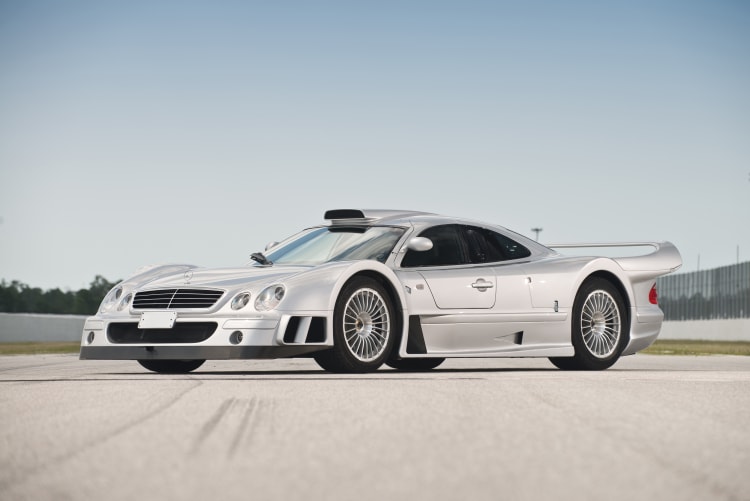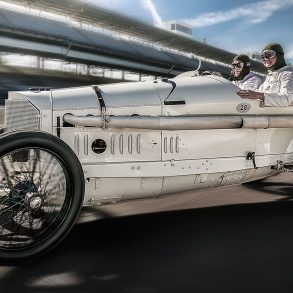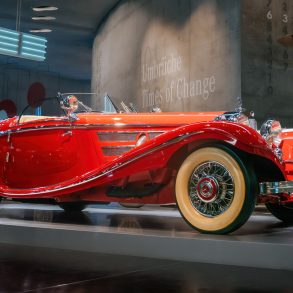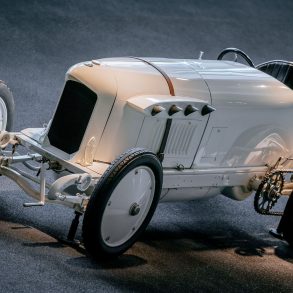Despite constantly pushing boundaries and creating dozens of fast and revolutionary models since its inception, Mercedes-Benz had long been reluctant to build a true supercar. It all changed in 1997 with the Mercedes-Benz CLK GTR.
Created out of pure necessity rather than passion or prestige, this atypical Mercedes-Benz announced the marque’s glorious return to top tier sports car racing.
The CLK GTR was everything a supercar should be; provocative, blisteringly fast, and exclusive, it was yet one thing more – deeply utilitarian. This is a story about the most radical Mercedes-Benz in recent history.
Background
When it came to racing, Mercedes-Benz was at an absolute peak in the 1950s, dominating the circuits and road races with automobiles like the W194 and the W196, in both Formula One and sports car configurations.


Thanks to the famous US-based importer Max Hoffman, the former became the 300SL Gullwing, while the latter didn’t spawn a roadworthy version, except for the 300 SLR Uhlenhaut coupé, a one-off personal vehicle of the legendary Mercedes-Benz racing principal Rudolf Uhlenhaut.
The glorious streak of triumphs came to a sudden halt at the 1955 24 Hours of the Le Mans. In a fiery crash between a 300 SLR and an Austin-Healey 3000, over 85 people lost their lives, including veteran endurance racer Pierre Levegh.

Out of respect for every soul lost on that sad day, Mercedes-Benz withdrew from the racing world. From the 1960s to the 1990s, they were present at the races through then-independent teams like AMG and as an engine supplier for Sauber.
As far as traditional, roadgoing supercars per se go, Mercedes-Benz was the closest to making one in the 1970s. When the wedge-shaped C111 concept car was unveiled in 1970, the demand to turn this design and technological study into a production vehicle exploded, but Mercedes-Benz was adamant not to expand its lineup with a vehicle so detached from its image of a conservative automotive manufacturer.

Again, in 1991, Mercedes-Benz presented the C112 study, a roadgoing variant of the Sauber race cars, but just like the C111 it remained just a technical exercise with no actual plans of small scale production.

The need for a street-going supercar emerged after the demise of the German touring car championship DTM in 1996. They were actively involved in the series with the W202 C-Class sedan, but with no active championships to run its touring cars, the company’s racing program turned to BPR Global GT Series, a sports car racing league gaining major ground among the private teams and manufacturers alike.
For the 1997 season, the BPR Global GT Series was set to become taken under FIA’s wing, thus becoming the FIA GT Championship. The championship’s growth saw a larger influx of manufacturers like Porsche, Lotus, and Panoz, all constructing their entries for the racing series.
Development
Seeing an opportunity to compete against Porsche and McLaren, Mercedes-Benz commissioned AMG to develop a race car loosely based on a model from the company’s lineup.
At the time, the most appropriate foundation was the CLK, a sporty coupé built on the W202 C-Class’ underpinnings and based on the E-Class’ design. The C208 CLK carried the company’s new identity with four oval lights, a radical departure from the conservative layout set in the mid-1970s.

Of course, there was little the two had in common as the requirements for the GT1 class were way beyond even the most powerful CLK 55 AMG. In fact, the supercar only shared the lights, the front grille, and some instrumentation with its plebeian counterpart, a bare minimum for it to be called a CLK.

Decades after the C111, Mercedes-Benz finally had a need for a supercar. The debut of the C-Class as an entry-level model in 1993 introduced the German company to the younger audience, while 1997 also saw the addition of the A-Class, a car utterly different from anything anyone could have expected from the Stuttgart-based company. Sitting on the opposite side of the spectrum from the unorthodox MPV-like hatchback, an overstated CLK GTR was exactly the right vehicle for the moment.
Mercedes CLK GTR
The development of the CLK GTR started from scratch and directly with racing in mind. From the earliest stages, Mercedes-AMG utilized a cunning method, enabling it to complete the prototypes in a record 128 days, just over four months.

The team managed to acquire an example of its fiercest and most direct competitor, the dominating McLaren F1 GTR, and to thoroughly examine its vital features.
Despite partnering for Formula One, they chose other means to take hold of the race car, secretly buying it from a French racing team Larbre Compétition. Once disassembled and analyzed, the vehicle was used as a test mule for the engine and the bodywork while the chassis for the CLK GTR was still in development at UK-based Lola Composites.

With the F1 GTR race car in its stables, Mercedes-AMG not only tested products of its own research and development but was able to compare it with the closest rival in real-time. Mercedes-AMG driver Bernd Schneider eventually crashed the test mule at Jarma and the mule was later sold and completely restored with its original engine back.
The longitudinally-mid-mounted 6.0-litre LS600 V12 was a derivative of the M120 engine and in race car spec, it produced approximately 600 horsepower at 7,000 RPM and 538 lb-ft of torque. It was mated to six-speed sequential manual transmission with

The two prototypes of the vehicles were finished just in time for the inaugural race of the 1997 season, on April 13th, 1997.
Frequently Asked Questions
The Guinness World records declared the Mercedes-Benz CLK GTR as the world’s most expensive production car with a price of $1,547,620.
A 1998 Mercedes-Benz CLK GTR was auctioned by RM Sotheby’s and sold for $4,515,000 USD.
The Mercedes-Benz CLK GTR is a street-legal race car that you can drive on the streets.
Mercedes only produced 25 CLK GTR. In order for Mercedes-Benz AMG to compete in the 1997 FIA GT championship, they were required to produce 25 homologated road cars.
Mercedes CLK LM
Knowing that the LS600 V12 was more suited for four-hour races than more demanding endurance races, Mercedes-AMG skipped the 1997 24 Hours of Le Mans to develop a special car for the next year’s rendition of the race.

The CLK LM was built on the same foundations of the CLK GTR, yet with revised bodywork and powerhouse.
To increase aerodynamic efficiency and top speed at long straights like the Mulsanne, the CLK LM had a noticeably lower front end with a one-piece cooling duct. As a result, its front fascia was stretched and looked even less like the CLK. Also, Mercedes-AMG changed the door mechanism to famous Gullwing doors in order to help the drivers switching positions quicker.
Still, the biggest alteration happened behind the cabin, in the engine compartment. Mercedes-AMG replaced the LS600 with a GT108B, a racing derivative of the M119 V8 engine. This unit already served in Sauber C9 and C111 cars where it was turbocharged, but for the CLK LM, Mercedes-AMG kept it naturally aspirated and gave it a slight increase in displacement.
The revised engine was good for 600 horsepower, but it didn’t find success on the Le Mans despite starting from pole position. However, the CLK LM crushed the competition in the 1998 FIA GT Championship. As per Le Mans’ regulations, the factory was obliged to create one roadgoing version, making the street variant of the CLK LM one of the rarest Mercedes-Benz road cars in history.
Road car
The demise of the FIA GT Championship for the 1999 season saw the company building just the race cars and the prototypes, while it was still obliged to produce 25 roadgoing vehicles, the minimal required number for homologation purposes.

In 1997, Mercedes-Benz built just one street-legal prototype to comply with the initial FIA demands, whereas the rest of the road cars were built in a span of a few months between late 1998 and mid-1999. In a true German manner, these vehicles were simply called CLK GTR Straßen Version, street version.

During this short production window, the AMG factory in Affalterbach assembled 26 road cars: 20 coupés and six roadsters. As an independent company closely cooperating with AMG, H.W.A. assisted in creating the roadsters out of unused chassis and building between two and five coupés to Super Sport specifications.

Out of a grand total of 26, just two RHD vehicles exist, one coupé and one roadster, and both were originally commissioned by the Sultan of Brunei, the most prominent car collector of the 1990s.
Chassis
As mentioned before, the Mercedes-Benz CLK GTR was a car built from the ground up despite sharing its name with a common coupé from the line-up. With that in mind, the chassis of the car greatly differed from the rest of the production models.

The skeleton of the CLK GTR was a carbon fiber monocoque built by Lola Composites, a UK-based company with a long tradition in the world of racing. The monocoque unit was mated to an aluminum honeycomb frame and the engine acted as a bearing member of the construction with rear suspension bolted onto it.
Body
Keeping the overall weight down to a total of 3,175 lb, the body of the Mercedes-Benz CLK GTR was built from carbon fiber and it didn’t differ much from the race version. Just like on a true race car, the trunk and the hood of the vehicle could be completely removed to expose the V12 engine and the front suspension setup.

Design-wise, the street version of the car retained the visual features from the tracks. The roof-mounted air duct, the ultra low front fenders, huge air dams behind the front wheels and NACA ducts on the sills were all present.

There were minor functional changes such as a set of larger fender-mounted side mirrors and a massive body-colored fixed rear wing. Both the coupé and the roadster version of the car had dihedral doors, a common sight on prototype sports cars of the period.
The open-top version of the car had a few cosmetic changes, namely the front grille with the large three-point star instead of a hood ornament and the rear wing which resembled the one seen on the racing variant of the vehicle. It also featured a revised midsection with an integrated roll bar, door-mounted mirrors and was 231 lb heavier.

Engine and Transmission
Similar to the CLK GTR race car, the street version’s powerhouse was a mid-longitudinally mounted V12. The engine was an M297 V12, AMG-tuned derivative of the M120 V12, the unit originally powering the S600 and SL600 flagship vehicles.

Still, the roadgoing supercar had a specially built engine tuned by Ilmor. The V12 was stroked to 6.9-litre displacement and it produced 604 hp at 6800 RPM and 572 lb-ft of torque at 5,250 RPM with a 7200 RPM redline.
The engine was mated to a six-speed competition Xtrac gearbox, via heavy duty four-plate carbon fibre clutch. Even though the gear shifting controls were mounted on the steering wheel, the CLK GTR had a clutch pedal.
Sheer V12 power translated to impressive numbers, with the 0-60 sprint of 3.8 seconds and the top speed of 205 MPH.
Finally, the elusive CLK GTR Super Sport was a later evolution of the car equipped with a larger 7.3-liter M297, the same unit found in the Pagani Zonda. In this specification, the vehicle produced 655 horsepower and 580 lb-ft. The Super Sport variant can be identified thanks to a redesigned front splitter or, if you take a peek inside, a speedometer etched to 400 km/h.
Steering and Suspension
As a race car on the streets, the car retained the basic suspension setup of the GT1 vehicle with horizontal double-wishbone front suspension both in the front and at the rear. However, the pull-rod actuated coil springs and dampers were softened and the ride height increased in order to make the CLK GTR a bit more street-friendly than its competing counterpart.

The vehicle utilized power-assisted rack-and-pinion steering with two turns to lock. In true race car fashion, it had an enormous 49.2-inch turning radius!
Brakes, Wheels and Tires
Unlike the race cars with no electronic assists, the car had ABS-assisted 6 piston calipers clenching the 380 mm front and 335 mm rear ventilated composite discs.

The CLK GTR had lightweight single-nut multispoke 18-inch wheels wrapped in Bridgestone 295/35ZR18 and 345/35ZR18 high performance tires.
Interior of the Mercedes-Benz CLK GTR
The beauty of the Mercedes-Benz CLK GTR’s interior lies in its simplicity. At a first glance, it looked like it was directly carried over from the CLK coupé, but then there are the subtle details and not so subtle features to prove everyone otherwise.

The CLK GTR was still a race car accommodated for the streets. So, in true race car fashion, the four-spoke AMG steering wheel was easily removable in order to enable the driver to even enter the cramped cockpit by hopping over an ultra wide sill.
Once the wheel was reattached, the dashboard looked very much like the CLK, but the finish was a bit crude to keep the race car aura alive, yet also to avoid building costs for unnecessary features like intricate pieces of trim on the center console. As a slight touch of convenience, the vehicles featured air conditioning and a slot for a radio, provided that anyone needed any music other than the howling AMG V12.

Given that the vehicle had sequential manual transmission, the gear shifting commands were positioned on the backside of the AMG steering wheel, while the front side had convenient reminders in form of upwards and downwards pointing arrows.
Behind the wheel and in true Mercedes-Benz fashion, the instrument cluster confidently displayed only water temperature and fuel level, while the dominating dial was a speedometer etched to 340 km/h.

When it came to finish, it differed from car to car. All of them had four point seat belts, yet some CLK GTRs were racier and had the dashboard wrapped in Alcantara, while the others were upholstered in fine soft leather. Still, the most interesting ones were two examples equipped with tartan-clad seats, a fitting throwback to the 300 SLR race car.

CLK GTR and CLK LM in Racing
1997
For the 1997 FIA GT1 Championship, the AMG-Mercedes teams were fronted by seasoned racers Alessandro Nannini and Bernd Schneider, with Marcel Tiemann and Alexander Wurz bringing fresh blood as second drivers for the Italian and the Austrian veteran respectively.

After an underwhelming start at the inaugural 1997 FIA GT Hockenheim 4 Hrs, Mercedes-AMG CLK GTR focused on fixing the issues and thus skipping the 24 Hours of the Le Mans.
As a result of development during the mid-season break, the cars started gaining momentum after the 1-2 win at Nürburgring 4 Hours, the fourth race of the season, where Shneider was joined by another veteran, Kremer Racing’s Klaus Ludwig.

Consistent performance and the addition of one more racing squad raked in more 1-2 wins at Zeltweg 4 Hrs, Suzuka 1000km, Donington 4 Hours, and victories at Sebring 3 Hrs and Laguna Seca 3 Hours. Throughout the season, the CLK GTR constantly battled against the McLaren F1 GTR and the Porsche 911 GT1, outperforming them both in the driver and constructor championships.
1998
The following season saw Mercedes-AMG saw two teams consisting of Bernd Schneider and Mark Webber in the CLK GTR and Ricardo Zonta and Klaus Ludwig. At the third race of the season, the 1998 FIA GT Hockenheim 500km, Mercedes-AMG switched to the V8-powered CLK LM.

Both CLK LMs suffered engine failure at the 1998 24 Hours of the Le Mans, but proved to be of greater success in the FIA GT Championship. In the 1998 season, Mercedes-AMG was an unstoppable force, winning ten out of ten races of the season, including six 1-2 victories. Klaus Ludwig and Ricardo Zonta won the championship over teammates Schneider and Webber. In the constructor championship, it annihilated Porsche with 146 points over 49.

Mercedes-AMG was so overpowered that it dismantled the FIA GT1 Championship as no manufacturers dared to enter the series, while the others just left.
That brought Mercedes-AMG to enter the 1999 season with the CLR, but that’s another, far less successful story.
Legacy
In its short but glorious racing career, the CLK GTR and CLK LM were dominant automobiles and their plate-wearing counterparts were just as equally stunning.
Today, the CLK GTR and CLK LM stand among the most valuable Mercedes-Benz collector cars and it’s no wonder frankly, given that both were built in extremely limited numbers and with astronomical price tags of $1,500,000 or $2,400,000 in today’s money, two times more than a McLaren F1.

As it usually goes with vehicles of such provenance, it’s still hard to measure their value on the collector car market, but it is worth noting that one car sold for $4,515,000 in 2018 at RM | Sotheby’s Monterey auction. That’s still a fraction of a price top collectors are willing to pay for a McLaren F1 GTR which sold for $19.8 million in 2019.
Given the current trends, the value of the CLK GTR will surely rise in the following years, but we’ll have to patiently wait and see whether it’ll ever top the F1 GTR. If it ever does, it will probably be the CLK LM, the car veiled in anonymity by the general public and the sole street going example of the car that conquered the GT1 championship.











Has any collector ever managed to backflip one of the road cars?